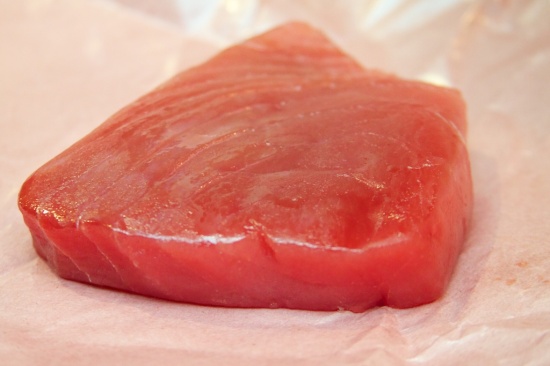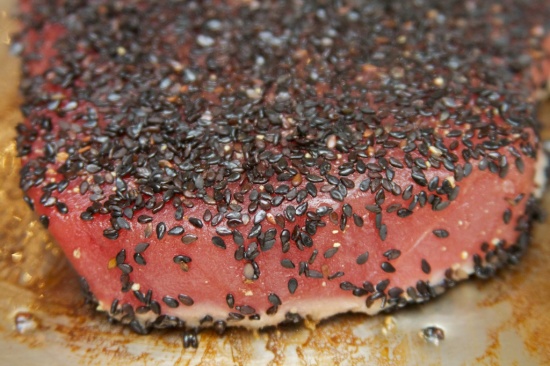
August 7, 2011 – homegrown “Sungold” and “Radiator Charlie’s Mortgage Lifter” tomatoes, basil, and burrata.
Between four and five months from now, if all goes well, we’ll be eating the tomatoes I planted this weekend. Most years, I wait until the very end of March before bringing tomato seeds to life in the safe, warm confines of my basement. With this mild winter, though, I decided to risk it.
Our little backyard has room for about 10 full-size tomato plants, plus a few other random veggies. Back in January, when the garden catalogues arrived, I carefully selected 5 varieties, and told myself that one of each would be it this year. But now… faced with an array of seed envelopes from the last 2 years, my resolve weakened. I planted three seeds for each of eleven varieties. Hopefully, that will leave me with one of each to plant, and at least one of each to give away.
Sungold – The only tomato we grow each and every year. Reliably, regardless of the weather, each plant produces literally hundreds of cherry-sized, golden orbs that pack huge, sweet flavour. The vine ends up taking over significant acreage in our tiny patio, but we never have the heart to prune it down to manageable size. Maybe this year…
Clear Pink – An early producer of large, light-pink fruit. We’ve grown this a couple of times. It’s a fun tomato because its unassuming looks – washed-out red, almost like the awful cellophane-packed winter tomatoes of my youth – conceal big, rich flavour.
Japanese Black Trifele – We tried this a couple of years ago, and I don’t recall it working out. But the descriptions of succulent, pear-shaped fruit with black-red bodies and green shoulders enticed me to try it again. We’ll see if these little guys germinate.

Radiator Charlie’s Mortgage Lifter – The big ones in the above picture. (The largest one there weighed in at almost 2 lbs.) This has been the ur-tomato for us: huge, heavy, juicy, salty-sweet and everything you want just by itself on a plate with a little pepper. It’s a bit finicky weather-wise, but when it works, there’s nothing better.
Black Krim – One of those dusky, smoky-tasting, rich tomatoes. Can be a bit thick-skinned, but the flavour and the colour are worth it. They’re the larger of the dark-shouldered tomatoes in the above picture. This is turning into a must-grow variety.
Black Prince – The smaller dark-shouldered ones pictured above. It’s been a couple of years since we grew these – I remember them being sweeter and drier than Black Krim, and not quite as interesting. But these things can change from year to year.

Yellow Tiger Stripe – These ones are hit-and-miss. In a bad year, they have leathery (if pretty) skins enveloping a cottony, mealy interior. In a good year, they brim with translucent neon-green gel that’s brightly flavoured. And they look great in a salad alongside their more traditionally clad cousins. If anyone out there has a suggestion for a more reliable green/yellow striped variety, let me know.
New this year:
Beefsteak and Brandywine – Two classic varieties, both large, meaty, slicing tomatoes. After having less-than-stellar luck with Radiator Charlie last summer, I wanted some guaranteed wins in this category. It’s also nice to have more than one such variety, each maturing at a slightly different time.
Black Cherry – all the delicious smokiness of the black varieties above, but with the promise of early maturation and a continuous supply.

Halved Sungold and Gardener’s Delight tomatoes, salt and olive oil, ready for a quick run under the broiler.
The seeds are nestled in a black plastic matrix, sitting atop a heating mat that will gently warm the soil to something that approximates a day in late May. In a few days, when they germinate, they’ll be placed under a standard, 2-bulb fluorescent shop-light – almost touching it. The cool light won’t scorch them, and they need to be as close as possible to it in order to grow bushy rather than spindly and leggy. A basement window provides some natural light, but the fluorescent light stays on from 7am to 11pm.
When the seedlings show signs of outgrowing their cells, I’ll transplant them to 4-inch plastic pots, burying them up to their lower leaves: the buried portion of the stems will sprout roots, giving the plants a stronger root system and preventing them from getting too top-heavy before they go in the ground. (The same process of burying the lower stems is repeated as the young plants are transferred to their outdoor homes.
Weather permitting, in late April, the plants will begin spending longer periods outside each day, preparing them for the shock of living outside full-time. This is usually the point at which I somehow manage to mix up the plants and forget which is which… until the tomatoes appear.
So tell us: what are you growing this year?








